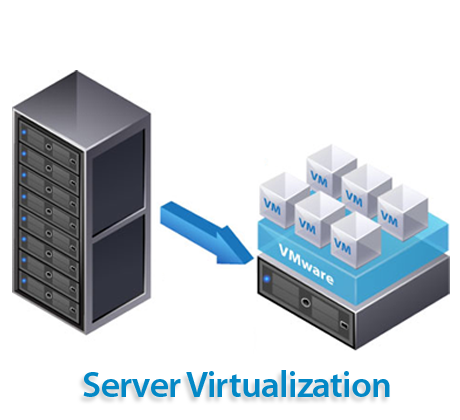Server virtualization is the process of creating multiple virtual servers on a single physical server. Virtual servers are isolated from each other and may have different sets of software and operating systems. Since they are consolidated on a single physical machine, you can use resources more efficiently, and save money.
This is necessary when running multiple applications or operating systems on a single server or when you need greater flexibility and scalability in resource management. The technology also simplifies disaster recovery and backup because virtual servers can be easily moved between physical machines.
Why is Server Virtualization Important?
-
Lower costs. To implement multiple projects it is easier to buy only one physical server and use virtualization to deploy several containers with the required resources and software.
-
Efficient use of resources. You can add additional resources (CPU, RAM, disk space) to any virtualized server with just a few clicks. You can also quickly and easily delete a server or shut down the current one. And moving a VM onto another physical server is easier than changing the hardware.
-
Security. Virtualization completely isolates virtual machines from each other. Software installed on one server has no effect on the software of another virtual server.
-
Improved backup and disaster recovery. With virtual servers, data backup and recovery is easier to manage because everything needed to run a particular application is stored in a virtualized image.
Finally, if an organization wants to rebuild its legacy infrastructure, a virtualized environment makes it easier to do so. There is no significant investment required, which means that costs can be reallocated to other areas of the business, or in some cases, eliminated altogether.
Types of virtualization
Depending on the implementation of the system, there are several types of virtualization.
- Hardware virtualization. This technology uses a hypervisor to create virtual machines. It divides guest operating systems into independent objects that share common server resources. When executing guest OS commands, the hypervisor directly accesses the hardware, without accessing the underlying operating system.
The advantage is that virtual machines do not affect the speed of others and cannot change the amount of resources allocated.
- Software virtualization uses a host-based type of hypervisor. This means that host resources are allocated by the hypervisor through an operating system layer. The guest operating system first contacts the hypervisor, which in turn sends commands to the host system. This technology allows you to run multiple virtual environments on a single server.
The advantages of this solution include high speed and ease of implementation. Software virtualization can be implemented on almost any hardware platform that has sufficient computing capacities. Resource allocation is a matter of a couple of clicks. Virtual machines are quickly deployed because there is no need to emulate all the hardware.
Software virtualization is especially convenient when it is necessary to use the capacities of an already running server, but at the same time not to affect the running software. The disadvantage is its relatively low performance: commands generated by the guest OS first pass through the hypervisor and the underlying system before reaching the hardware itself.
Benefits of Server Virtualization
The main advantage is that systems do not depend on physical hardware. Virtualization allows for server consolidation, when a single server runs dozens and hundreds of virtual machines, running on the same physical resources. With this approach, the enterprise saves on infrastructure purchase and maintenance. Instead of several servers, the company buys one, but a more powerful. There is no need to allocate separate physical machines for mail, files, domain servers, etc.

Virtualization technologies speed up the development cycle of software products. Programmers can test, identify, and eliminate all bugs and weaknesses before release.
For companies with a network of offices in different locations, virtualization allows them to reduce the time it takes to build and maintain their IT infrastructure. For remote employees it is beneficial to simply set up remote desktops, providing access to personal workspaces via the Internet. All computing operations are performed on the server side, with applications and data stored there as well. Employees only receive images on the screen of the device and use input devices to send control commands to the server side.
One more benefit of server virtualization is improved disaster recovery and backup capabilities. Virtual servers can be easily backed up and replicated to other physical machines. In the event of a hardware failure or disaster, they can be quickly restored on another machine without downtime or data loss.
Overall, virtualization is a powerful tool for improving efficiency, reducing costs, and increasing flexibility in managing server resources. It has become popular in recent years as more businesses look for ways to improve their operations.



